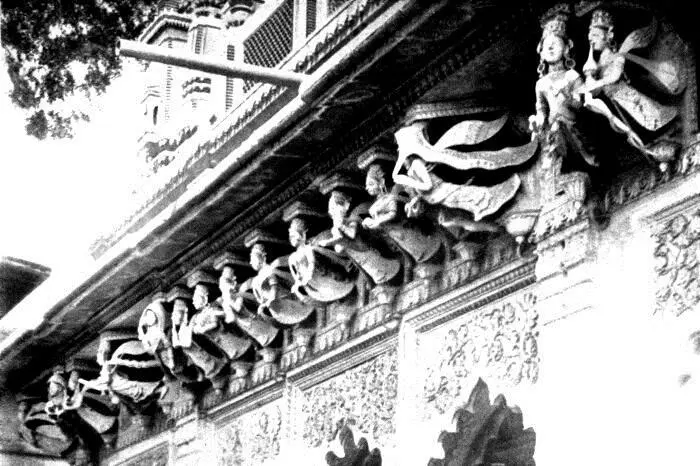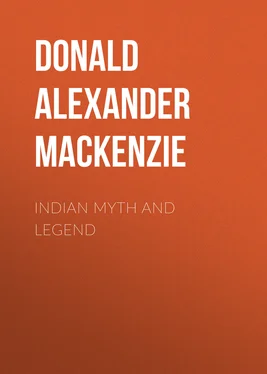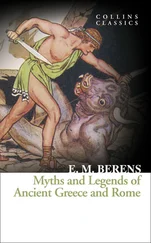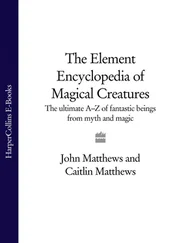Donald Alexander Mackenzie - Indian Myth and Legend
Здесь есть возможность читать онлайн «Donald Alexander Mackenzie - Indian Myth and Legend» — ознакомительный отрывок электронной книги совершенно бесплатно, а после прочтения отрывка купить полную версию. В некоторых случаях можно слушать аудио, скачать через торрент в формате fb2 и присутствует краткое содержание. Жанр: foreign_prose, foreign_religion, Философия, Мифы. Легенды. Эпос, foreign_psychology, foreign_antique, на английском языке. Описание произведения, (предисловие) а так же отзывы посетителей доступны на портале библиотеки ЛибКат.
- Название:Indian Myth and Legend
- Автор:
- Жанр:
- Год:неизвестен
- ISBN:нет данных
- Рейтинг книги:4 / 5. Голосов: 1
-
Избранное:Добавить в избранное
- Отзывы:
-
Ваша оценка:
- 80
- 1
- 2
- 3
- 4
- 5
Indian Myth and Legend: краткое содержание, описание и аннотация
Предлагаем к чтению аннотацию, описание, краткое содержание или предисловие (зависит от того, что написал сам автор книги «Indian Myth and Legend»). Если вы не нашли необходимую информацию о книге — напишите в комментариях, мы постараемся отыскать её.
Indian Myth and Legend — читать онлайн ознакомительный отрывок
Ниже представлен текст книги, разбитый по страницам. Система сохранения места последней прочитанной страницы, позволяет с удобством читать онлайн бесплатно книгу «Indian Myth and Legend», без необходимости каждый раз заново искать на чём Вы остановились. Поставьте закладку, и сможете в любой момент перейти на страницу, на которой закончили чтение.
Интервал:
Закладка:
Kali, a demon who holds friendly converse with the gods in the “Story of Nala”, is attended by Dwápara, a flesh-eater like the Pisachas. The Panis are aerial demons, who are hated by bluff, honest Indra, because they are the inspirers of foolish actions, slander, and unbelief, and the imps who encourage men to neglect homage to deities. The black Dasyus are repulsive of aspect and jealous-hearted; they are the stealers of the cloud cows who are held captive for Vritra in the cave of the demon Vala. The Darbas, “the tearers”, are a variety of Pisachas. Reference is made in Mahabharata to “ugly Vartikas of dreadful sight, having one wing, one eye, and one leg”; when they “vomit blood, facing the sun”, a dreadful happening is known to be at hand, because they are fiends of evil omen.
Among the supernatural beings who are sometimes the enemies, but in most cases the friends of mankind, are the Yakshas, the Gandharvas, and the Apsaras (Apsarasas).
The Yakshas are occasionally referred to as the Punyajanas, “the good people”; they may be of human stature, with big benevolent eyes, or powerful giants who can fight as fiercely as Rakshasas. They are guardians of hidden treasure, like the dwarfs and giants of Teutonic legend, being associated with Kuvera, god of wealth, whose abode is situated among the Himalayan mountains. In Kuvera's domain are found “multitudes of spirits” who do not visit the world of men as a rule, but remain near the treasure for purposes of defence; “some are of dwarfish stature, some of fierce visage, some hunchbacked, some of blood-red eyes, some of frightful yells; some are feeding upon fat and flesh, and some are terrible to behold; and all are armed with various weapons, and endued with the speed of the wind”. 124

14
THE CELESTIAL FAIRIES (APSARAS)
Sculpture on a modern Hindu Temple, Benares
The Gandharvas are grouped in tribes, and number over six thousand individuals. They are all of the male sex. They haunt the air, the forests, and the mountains, and, like the Rakshasas, have power to work illusions in the grey twilight before nightfall. References are made in the Epics to their combats with human beings. To warriors who overcome them they impart instruction in religious matters; those whom they conquer they carry away, like the Teutonic elves and dwarfs. The Gandharvas are renowned musicians and bards and singers. When they play on their divine instruments the fairy-like Apsaras, who are all females, dance merrily. In the various Aryan heavens these elves and fairies delight and allure with music and song and dance the gods, and the souls of those who have attained to a state of bliss. The Apsara dancing girls are “voluptuous and beautiful”, and inspire love in Paradise as well as upon earth. Their lovers include gods, Gandharvas, and mortals. Arjuna, the human son of Indra, who was transported in a Celestial chariot to Swarga over Suravithi, “the Milky Way”, was enchanted by the music and songs and dances of the Celestial elves and fairies. He followed bands of Gandharvas who were “skilled in music sacred and profane”, and he saw the bewitching Apsaras, including the notorious Menaka, “with eyes like lotus blooms, employed in enticing hearts”; they had “fair round hips and slim waists”, and “began to perform various evolutions, shaking their deep bosoms and casting their glances around, and exhibiting other attractive attitudes capable of stealing the hearts and resolutions and minds of the spectators”. 125
In the Rigveda there is a water-nymph, named Apsaras; she is the “spouse” of Gandharva, an atmospheric deity who prepares Soma for the gods and reveals divine truths to mortals. They vanish, however, in later times; the other Vedas deal with the spirit groups which figure so prominently in the Epics. No doubt the groups are older than Gandharva, the god, and Apsaras, the goddess, who may be simply the elf-king and the fairy-queen. The “black” Dasyus are sometimes referred to by modern-day writers as the dark aborigines who were displaced by the Aryans; a tribal significance is also given to the Rakshasas and the Gandharvas. But this tendency to identify the creatures of the spirit world with human beings may be carried too far. If “Dasyus” were really “dark folk”, 126it should be remembered that in Teutonic mythology there are “black dwarfs”, who live in underground dwellings, and “white elves” associated with air and ocean; there are also black and white fairies in the Scottish Highlands, so that black and white spirits may simply belong to night and day spirit groups. It may be that the Indian aborigines were referred to contemptuously as Dasyus by the Aryans. The application of the names of repulsive imps to human enemies is not an unfamiliar habit even in our own day; in China the European is a “foreign devil”, but Chinese “devils” existed long before Europeans secured a footing in the Celestial Kingdom. Those who seek for a rational explanation for the belief in the existence of mythical beings should remember that primitive man required no models for the creatures of his fancy. He symbolized everything—his ideals, his desires, his hopes and his fears, the howling wind, the low whispering breeze, the creaking tree, the torrent, the river, the lake, and the mountain; he heard the hammer or the trumpet of a mighty god in the thunderstorm, he believed that giants uprooted trees and cast boulders down mountain slopes, that demons raised ocean billows in tempest, and that the strife of the elements was a war between gods and giants; day and night, ever in conflict, were symbolized, as were also summer and winter, and growth and decay. If the fairies and elves of Europe are Lapps, or the small men of an interglacial period in the Pleistocene Age, and if the Dasyus and Gandharvas of India are merely Dravidians and pre-Dravidians who resisted the Aryan invasion, who, then, it may be asked, were the prototypes of the giants “big as mountains”, or the demons like “trees walking”, the “tiger-headed” Rakshasas, “ugly Vartikas” with “one wing, one eye, and one leg”? and what animal suggested Vritra, or the fiery dragon that burned up daylight, or Rahu, the swallower of sun and moon? If the redhaired and red-bearded Rakshasas are to be given a racial significance, what of the blue Rakshasas and the green? The idea that primitive man conceived of giants because he occasionally unearthed the bones of prehistoric monsters, is certainly not supported by Scottish evidence; Scotland swarms with giants and hags of mountain, ocean, and river, although it has not yielded any great skeletons or even a single artifact of the Palæolithic Age. Giants and fairies are creations of fancy. Just as a highly imaginative child symbolizes his fears and peoples darkness with terrifying monsters, so, it may be inferred, did primitive man who crouched in his cave, or spent sleepless nights in tempest-stricken forests, conceive with childlike mind of demons thirsting for his blood and giants of wind and fire intent on destroying the Universe.
In India, as elsewhere, the folk of the spirit world might woo or be wooed by impressionable mortals. A Gandharva related to Arjuna, the Pandava prince, by whom he was defeated in single combat, the “charming story”, as he called it, of King Samvarana and the fairy-like Tapati, a daughter of the sun god, Surya. Tapati was of all nymphs the most beautiful; she was “perfectly symmetrical” and “exquisitely attired”; she had “faultless features, and black, large eyes”; and, in contrast to an Apsara, she “was chaste and exceedingly well conducted”. For a time the sun god considered that no husband could be found who was worthy of his daughter; and therefore “knew no peace of mind, always thinking of the person he should select”. One day, however, King Samvarana worshipped the sun, and made offerings of flowers and sweet perfumes, and Surya resolved to bestow his daughter upon this ideal man.
Читать дальшеИнтервал:
Закладка:
Похожие книги на «Indian Myth and Legend»
Представляем Вашему вниманию похожие книги на «Indian Myth and Legend» списком для выбора. Мы отобрали схожую по названию и смыслу литературу в надежде предоставить читателям больше вариантов отыскать новые, интересные, ещё непрочитанные произведения.
Обсуждение, отзывы о книге «Indian Myth and Legend» и просто собственные мнения читателей. Оставьте ваши комментарии, напишите, что Вы думаете о произведении, его смысле или главных героях. Укажите что конкретно понравилось, а что нет, и почему Вы так считаете.












